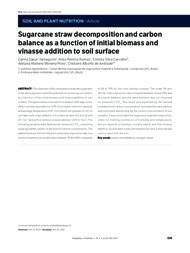Sugarcane straw decomposition and carbon balance as a function of initial biomass and vinasse addition to soil surface.
Sugarcane straw decomposition and carbon balance as a function of initial biomass and vinasse addition to soil surface.
Author(s): YAMAGUCHI, C. S.; RAMOS, N. P.; CARVALHO, C. S.; PIRES, A. M. M.; ANDRADE, C. A. de
Summary: Abstract: The objective of this study was to evaluate sugarcane straw decomposition and the potential of increasing soil carbon as a function of the initial biomass and vinasse addition to soil surface. The experimente consisted of incubation (240 days, in the dark, humidity equivalent to 70% of soil water retention capacity and average temperature of 28 °C) of Oxisol soil samples (0-20 cm soil layer) with straw added to soil surface at rates of 2; 4; 8; 16 and 24 t.ha-1 and with or without vinasse addition (200 m3.ha-1). The following variables were determined: released C-CO2, remaining straw dry matter, carbon straw and soil carbon concentration. The added biomass did not influence straw decomposition rate, but vinasse treatments provided rates between 70 and 94% compared to 68 to 75% for the ones without vinasse. The straw (16 and 24 t.ha-1) decomposition rate increased between 14 and 35% due to vinasse addition, but the same behavior was not observed for released C-CO2. This result was explained by the twofold increase of soil carbon concentration, estimated by mass balance and confirmed analytically by the carbon concentration of soil samples. It was concluded that sugarcane straw decomposition, under no limiting conditions of humidity and temperature, did not depend on biomass initially added and that vinasse addition accelerated straw decomposition and potentialized carbon input into the soil.
Publication year: 2017
Types of publication: Journal article
Unit: Embrapa Environment
Keywords: Cana-de-açúcar, Mineralization, Mineralização, Nitrogen, Nitrogênio, Palha, Straw, Sugarcane, Vinasse, Vinhaça
Observation
Some of Embrapa's publications are published as ePub files. To read them, use or download one of the following free software options to your computer or mobile device. Android: Google Play Books; IOS: iBooks; Windows and Linux: Calibre.
Access other publications
Access the Agricultural Research Database (BDPA) to consult Embrapa's full library collection and records.
Visit Embrapa Bookstore to purchase books and other publications sold by Embrapa.

